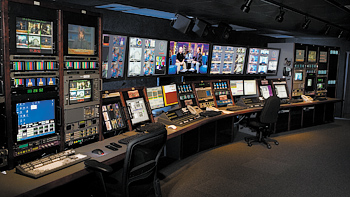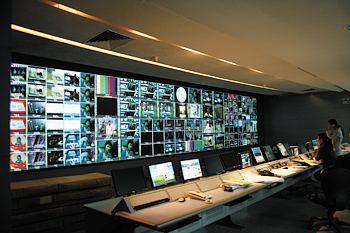Monitoring in the Era of Multitasking
SEATTLE
Monitoring technology in the television industry has remained—for the longest time—the domain of the cathode ray tube, the CRT. True, the best of the best of them, evaluation grade monitors, kept inching up in quality. But CRTs were a maintenance nightmare, generated a lot of heat, and took up a lot of space. And they were a bear to color match. Hence the old editing-suite joke:
Client: Which one of the monitors is the real color of my video?
Editor: Which one do you like the best?

TV Magic recently installed this multiviewer at Trinity Broadcasting Network's new facility in New York City. But when the dam broke, and broadcasting and related industries broke away from CRTs, it was quick. A check of the 2009 NAB Show exhibitor search directory for the letters CRT produces a "No results found" response. If you can find one on the show floor this year, it'll likely be in a museum exhibit.
OFF THE WALL
And as CRTs were replaced, the industry found that multiple display technology already in the large display market. "We came up with a new way to build a video wall," said Jamie Horner, senior product manager from multiview software maker Evertz. "So rather than just replace the [CRT] technology, they were able to use the new technology on the street to replace CRTs."
In the beginning a control room builder had a choice between LCD screens, which weren't much bigger than the CRTs they replaced, and the DLP (digital light processing) front screen or rear screen projection systems, which could provide a considerably larger display. But ambient light can be a problem with projection systems.
"In the darkest spaces the picture looks terrific coming off the projection system," said Andy Fliss, vice president of sales and marketing for Aurora Multimedia, a Morganville, N.J.-based provider of advanced A/V processing technology. "But add some lighting and it's going to affect the image, where displays with their own light sources aren't affected nearly as much."
And then, as the availability of high definition television programming rose, the consumer marketplace for larger LCD screens picked up, larger LCD monitors became available (at lower prices), many broadcasters moved to large flat panel screens.
DIFFERENT NEEDS
Multiview system manufacturers said that there's a big difference between the wants and needs of the live production control room versus a master control application.
"In production, you don't want any more than maybe 12 on a single, big LCD, because that's how much a switcher can really handle," said Thomas Tang, president of Apantec, a Portland, Ore.-based provider of multiviewers. "Say you're in a transmission center, a master control room, then you can start doing 16, 24, 48 sources, even bigger numbers. I've seen as many as 80 sources in a room."
It also comes down to what crew members in those two different environments need from their monitors.
"For production control, where they make a judgment call on the source, whether they call the camera up, they need to know where the camera pointed, what it sees," said Louis Caron, product specialist, multi-image, at Miranda Technologies in Montreal.
Kevin Jackson, multiviewers product manager for Harris Broadcast, said that in master control, it's all about number of sources and signal quality. "They want the ability to monitor everything about the source, they want [quality of service] alarming capability, they want information about the quality of the video, and things like what's present, close captioning, aspect ratio, that type of information."

Norway's Public Broadcaster, NRK has modernized its News Centre with "NASA" style control room based around Miranda's Kaleido X Multi-Image Processors which feeds more than 20 screens. Add to that source audio monitoring bar graphs, under monitor source name displays, tally, timecode and source of the video. These all required extra pieces of hardware and/or display equipment during the CRT era.
In any event, the master control monitor walls retain their normal setup, day after day, where a studio or OB van control room monitor wall may be reconfigured several times daily to handle different program production needs. But for either application, scalability, the capability to display more sources and feed more monitors by adding hardware, is an important factor in evaluating systems.
Early adopters of large-screen multiview monitoring were often stuck with standard definition resolution, which limited the ratio of screen size and how close an operator could sit to the screen and still see a clear picture. Vendors seem in agreement that that's largely a thing in the past, with economical 1080p large screen solutions. The resolution of the multiview system itself is a competitive selling point that can be determined by a vendor shoot out.
But in fact, rather than monitor resolution being the problem, sitting too close to a monitor wall can cause the areas to the side to be out of the comfortable viewing angle of the operator. To alleviate the need to crane the neck, monitor walls are often configured to put repeats of video source displays in front of the operator so he can easily see the sources he'll need to do his job.
Crew members in other rooms, in other OB vans, or in other buildings can have their multiview monitors fed off of many of the multiview systems. Barco Market Director for Broadcast and Tele-com Steven Luys said that using the IP connection in their multiview system allows multiview monitoring "to pick the sources from places that are miles away or thousands of miles away, bring it over satellite…" He even suggested a chief engineer could monitor video sources at the station from the comfort of a PC at home over the Web.
Get the TV Tech Newsletter
The professional video industry's #1 source for news, trends and product and tech information. Sign up below.
